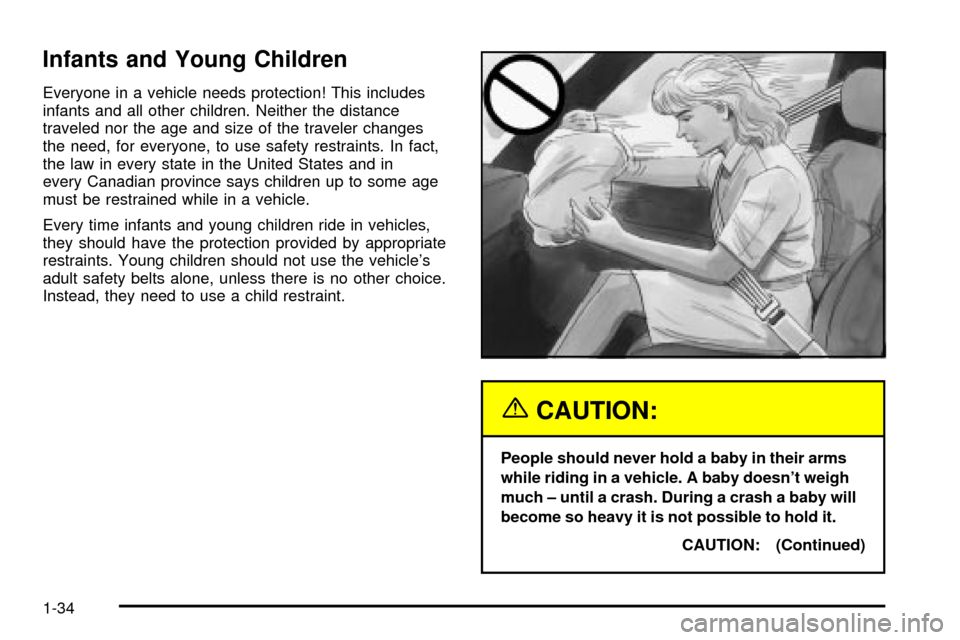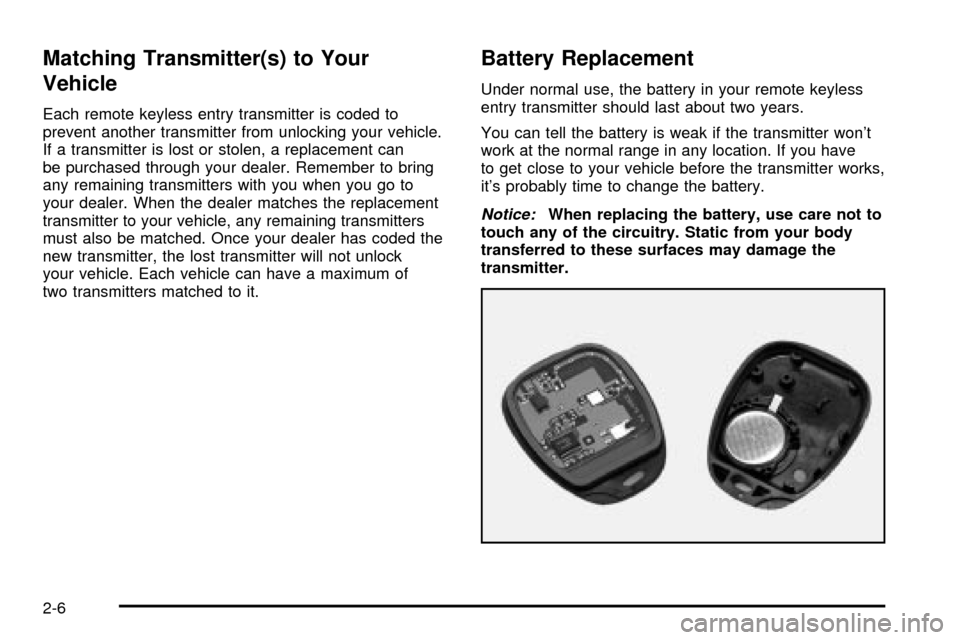change time CHEVROLET TRACKER 2003 2.G Owners Manual
[x] Cancel search | Manufacturer: CHEVROLET, Model Year: 2003, Model line: TRACKER, Model: CHEVROLET TRACKER 2003 2.GPages: 372, PDF Size: 2.65 MB
Page 2 of 372

GENERAL MOTORS, GM, the GM Emblem,
CHEVROLET, the CHEVROLET Emblem and the
name TRACKER are registered trademarks of
General Motors Corporation.
This manual includes the latest information at the time it
was printed. We reserve the right to make changes
after that time without further notice. For vehicles ®rst
sold in Canada, substitute the name ªGeneral Motors of
Canada Limitedº for Chevrolet Motor Division whenever
it appears in this manual.
Please keep this manual in your vehicle, so it will be
there if you ever need it when you're on the road. If you
sell the vehicle, please leave this manual in it so the
new owner can use it.
Litho in U.S.A.
Part No. 22683299 B First Edition
Copyright General Motors Corporation 07/15/02
All Rights Reserved
Canadian Owners
You can obtain a French copy of this manual from your
dealer or from:
Helm, Incorporated
P.O. Box 07130
Detroit, MI 48207
About Driving Your Vehicle
As with other vehicles of this type, failure to operate this
vehicle correctly may result in loss of control or an
accident. Be sure to read the ªon-pavementº and
ªoff-roadº driving guidelines in this manual. See
Your
Driving, the Road, and Your Vehicle on page 4-2
andOff-Road Driving with Your Four-Wheel-Drive
Vehicle on page 4-16.
How to Use This Manual
Many people read their owner's manual from beginning to
end when they ®rst receive their new vehicle. If you do
this, it will help you learn about the features and controls
for your vehicle. In this manual, you will ®nd that pictures
and words work together to explain things.
ii
Page 40 of 372

Infants and Young Children
Everyone in a vehicle needs protection! This includes
infants and all other children. Neither the distance
traveled nor the age and size of the traveler changes
the need, for everyone, to use safety restraints. In fact,
the law in every state in the United States and in
every Canadian province says children up to some age
must be restrained while in a vehicle.
Every time infants and young children ride in vehicles,
they should have the protection provided by appropriate
restraints. Young children should not use the vehicle's
adult safety belts alone, unless there is no other choice.
Instead, they need to use a child restraint.
{CAUTION:
People should never hold a baby in their arms
while riding in a vehicle. A baby doesn't weigh
much ± until a crash. During a crash a baby will
become so heavy it is not possible to hold it.
CAUTION: (Continued)
1-34
Page 72 of 372

Remote Keyless Entry System
If equipped, the remote keyless entry system operates
on a radio frequency subject to Federal Communications
Commission (FCC) Rules and with Industry Canada.
This device complies with Part 15 of the FCC Rules.
Operation is subject to the following two conditions:
1. This device may not cause interference, and
2. This device must accept any interference received,
including interference that may cause undesired
operation of the device.
This device complies with RSS-210 of Industry Canada.
Operation is subject to the following two conditions:
1. This device may not cause interference, and
2. This device must accept any interference received,
including interference that may cause undesired
operation of the device.
Changes or modi®cations to this system by other than
an authorized service facility could void authorization to
use this equipment.At times you may notice a decrease in range. This is
normal for any remote keyless entry system. If the
transmitter does not work or if you have to stand closer
to your vehicle for the transmitter to work, try this:
·Check the distance. You may be too far from your
vehicle. You may need to stand closer during
rainy or snowy weather.
·Check the location. Other vehicles or objects may
be blocking the signal. Take a few steps to the
left or right, hold the transmitter higher, and
try again.
·Check to determine if battery replacement or
resynchronization is necessary. See ªBattery
Replacementº and ªResynchronizationº under
ªRemote Keyless Entry System Operationº following
this section.
·If you are still having trouble, see your dealer or a
quali®ed technician for service.
2-4
Page 74 of 372

Matching Transmitter(s) to Your
Vehicle
Each remote keyless entry transmitter is coded to
prevent another transmitter from unlocking your vehicle.
If a transmitter is lost or stolen, a replacement can
be purchased through your dealer. Remember to bring
any remaining transmitters with you when you go to
your dealer. When the dealer matches the replacement
transmitter to your vehicle, any remaining transmitters
must also be matched. Once your dealer has coded the
new transmitter, the lost transmitter will not unlock
your vehicle. Each vehicle can have a maximum of
two transmitters matched to it.
Battery Replacement
Under normal use, the battery in your remote keyless
entry transmitter should last about two years.
You can tell the battery is weak if the transmitter won't
work at the normal range in any location. If you have
to get close to your vehicle before the transmitter works,
it's probably time to change the battery.
Notice:When replacing the battery, use care not to
touch any of the circuitry. Static from your body
transferred to these surfaces may damage the
transmitter.
2-6
Page 85 of 372

Notice:Holding your key in START for longer than
15 seconds at a time will cause your battery to
be drained much sooner. And the excessive heat
can damage your starter motor. Wait about
15 seconds between each try to help avoid
draining your battery or damaging your starter.
2. If it doesn't start, push the accelerator pedal
one-third of the way down. Hold it there, for
not more than 15 seconds at a time, while you
turn your key to START. When the engine starts,
let go of the key and release the pedal.
Wait about 15 seconds between each try.
3. If your engine still won't start (or starts but then
stops), it could be ¯ooded with too much gasoline.
Try pushing your accelerator pedal all the way to the
¯oor and holding it there as you hold the key in
START for about three seconds. If the vehicle starts
brie¯y but then stops again, do the same thing,
but this time keep the pedal down for ®ve or
six seconds. This clears the extra gasoline from
the engine.
Notice:Your engine is designed to work with the
electronics in your vehicle. If you add electrical
parts or accessories, you could change the way the
engine operates. Before adding electrical equipment,
check with your dealer. If you do not, your engine
might not perform properly.
Engine Coolant Heater
If your vehicle has this feature, in very cold weather,
0ÉF (18ÉC) or colder, the engine coolant heater can help.
You'll get easier starting and better fuel economy
during engine warm-up. Usually, the coolant heater
should be plugged in a minimum of four hours prior to
starting your vehicle. At temperatures above 32ÉF (0ÉC),
use of the coolant heater is not required.
2-17
Page 121 of 372

Cruise Control
If your vehicle has cruise control, you can maintain a
speed of about 25 mph (40 km/h) or more without
keeping your foot on the accelerator. This can really
help on long trips. Cruise control will not set at speeds
below about 25 mph (40 km/h).
{CAUTION:
·Cruise control can be dangerous where
you can not drive safely at a steady speed.
So, do not use your cruise control on
winding roads or in heavy traffic.
·Cruise control can be dangerous on
slippery roads. On such roads, fast
changes in tire traction can cause
needless wheel spinning, and you could
lose control. Do not use cruise control on
slippery roads.
Setting Cruise Control
1. Press the CRUISE
ON/OFF button located
on the instrument panel
to turn the system on.
The indicator light in the
button will come on.
Wait at least one
second after turning
the system on before
setting a speed.
Once the CRUISE ON/OFF switch is turned on,
it will come on each time you start your vehicle until
you manually turn if off.
3-9
Page 125 of 372

Daytime Running Lamps
Daytime Running Lamps (DRL) can make it easier for
others to see the front of your vehicle during the
day. DRL can be helpful in many different driving
conditions, but they can be especially helpful in the short
periods after dawn and before sunset. Fully functional
daytime running lamps are required on all vehicles
®rst sold in Canada.
The DRL system will make your headlamps come on at
a reduced brightness when the three following
conditions are met:
·The ignition is on with the engine running,
·the exterior lamps control is off or the parking lights
are on, and
·the parking brake is released.
When the DRL are on, only your headlamps will be on
at a reduced brightness. The taillamps, sidemarker
and other lamps won't be on. Your instrument panel
won't be lit up either.When you move the exterior lamps control to the
headlamp position, your DRL will go off and your
headlamps will come on. The other lamps that come on
with your headlamps will also come on.
When it begins to get dark, the headlamps will
automatically switch from DRL to the regular headlamps.
See ªAutomatic Headlamp Systemº following.
When you turn the exterior lamp control to off, the
regular lamps will go off and your headlamps will change
to the reduced brightness of DRL provided it is not
dark outside. DRL will also come on if only the parking
lamps are being used.
As with any vehicle, you should turn on the regular
headlamp system when you need it.
3-13
Page 126 of 372

Automatic Headlamp System
Your vehicle is equipped with an automatic light sensor
on top of the instrument panel, on the passenger's
side of the vehicle, so be sure it is not covered. If it is,
the headlamps will remain on continuously.
There is a delay in the transition between the daytime
and nighttime operation of the DRL and the Automatic
Headlamp Systems so that driving under bridges or
bright overhead street lights does not affect the system.
The DRL and Automatic Headlamp Systems will only
be affected when the light sensor sees a change
in lighting lasting longer than this delay.
When it is dark enough outside, or you are driving
through a parking garage, heavy overcast weather
or a tunnel, the system will turn on your low-beam
headlamps at normal brightness. Along with your
vehicle's headlamps, the taillamps, sidemarker, parking
lamps and the instrument panel lights will also turn
on. The radio display will dim.
As with any vehicle, you should turn on the regular
headlamps when you need them.To temporarily disable your vehicle's DRL and Automatic
Headlamp Systems functions, do the following:
1. Before turning the ignition key to ON or START,
set the parking brake.
2. Then turn the ignition key to ON or START.
·The Automatic Headlamp System will not turn on
under any conditions, even in darkness.
·The DRL will not turn on.
The DRL and Automatic Headlamp System functions will
stay off with the ignition on, until you release the parking
brake. Once the parking brake is released the DRL will
turn on if it is daylight or the Automatic Headlamp System
will turn on if it is dark enough outside.
If you turn the ignition key to ON or START and then set
the parking brake, the DRL will turn off (in all conditions)
and the Automatic Headlamp System will remain on
(if dark enough outside). Any other uses of the parking
brake after the engine is turned on will have no effect on
the normal Automatic Headlamp System operation.
Headlamps On Reminder
If you turn the ignition off, remove the key, open the
door and leave the lamps on, a tone will remind you to
turn off your lamps.
3-14
Page 131 of 372

:(Outside Air):Slide the lower right lever to the
right for outside air. With the lever in this position,
outside air will circulate throughout your vehicle.
?(Recirculation):Slide the lower right lever to the
left for recirculated air. With the lever in this position
outside air and odors can be prevented from entering
your vehicle and also helps heat or cool the air
inside your vehicle more quickly.
If the lever is in the middle of the two positions, you will
have both outside and recirculated air inside your
vehicle.
If you are in city traffic, your vehicle is stopped and
idling or the weather is hot, the system may be switched
from the outside air mode to the recirculation mode.
To help prevent the air inside of your vehicle from
becoming too stale, be sure to return to outside air
periodically.
Temperature Control:Slide the lever located on the
lower left side to change the temperature. Move it to
the right for warmer air and to the left for cooler
air. Without air conditioning, the air temperature cannot
be less than the outside air temperature.Air Conditioning (A/C):Press the air conditioning
(A/C) button to turn the air-conditioning system on or off.
When A/C is pressed, an indicator light in the button
will come on to let you know that the air conditioning is
activated.
On hot days, open the windows to let hot inside air
escape; then close them. This helps to reduce the time
it takes for your vehicle to cool down. It also helps
the system to operate more efficiently.
For quick cool down on hot days:
1. Select the vent mode.
2. Select the recirculation mode.
3. Select A/C.
4. Select the coolest temperature.
5. Select the highest fan speed.
The air-conditioning system removes moisture from the
air, so you may sometimes notice a small amount of
water dripping underneath your vehicle while idling
or after turning off the engine. This is normal.
3-19
Page 166 of 372

Remember: Anti-lock does not change the time you
need to get your foot up to the brake pedal or always
decrease stopping distance. If you get too close to
the vehicle in front of you, you will not have time to apply
your brakes if that vehicle suddenly slows or stops.
Always leave enough room up ahead to stop, even
though you have anti-lock brakes.
Using Anti-Lock
Do not pump the brakes. Just hold the brake pedal
down ®rmly and let anti-lock work for you. You may feel
a slight brake pedal pulsation or notice some noise,
but this is normal.
Braking in Emergencies
At some time, nearly every driver gets into a situation
that requires hard braking.
If you have anti-lock, you can steer and brake at the
same time. However, if you do not have anti-lock,
your ®rst reaction Ð to hit the brake pedal hard and
hold it down Ð may be the wrong thing to do.Your wheels can stop rolling. Once they do, the vehicle
can not respond to your steering. Momentum will
carry it in whatever direction it was headed when the
wheels stopped rolling. That could be off the road, into
the very thing you were trying to avoid, or into traffic.
If you do not have anti-lock, use a ªsqueezeº braking
technique. This will give you maximum braking
while maintaining steering control. You can do this by
pushing on the brake pedal with steadily increasing
pressure.
In an emergency, you will probably want to squeeze the
brakes hard without locking the wheels. If you hear or
feel the wheels sliding, ease off the brake pedal.
This will help you retain steering control. If you
dohave
anti-lock, it is different. See ªAnti-Lock Brake Systemº
in this section.
In many emergencies, steering can help you more than
even the very best braking.
4-10